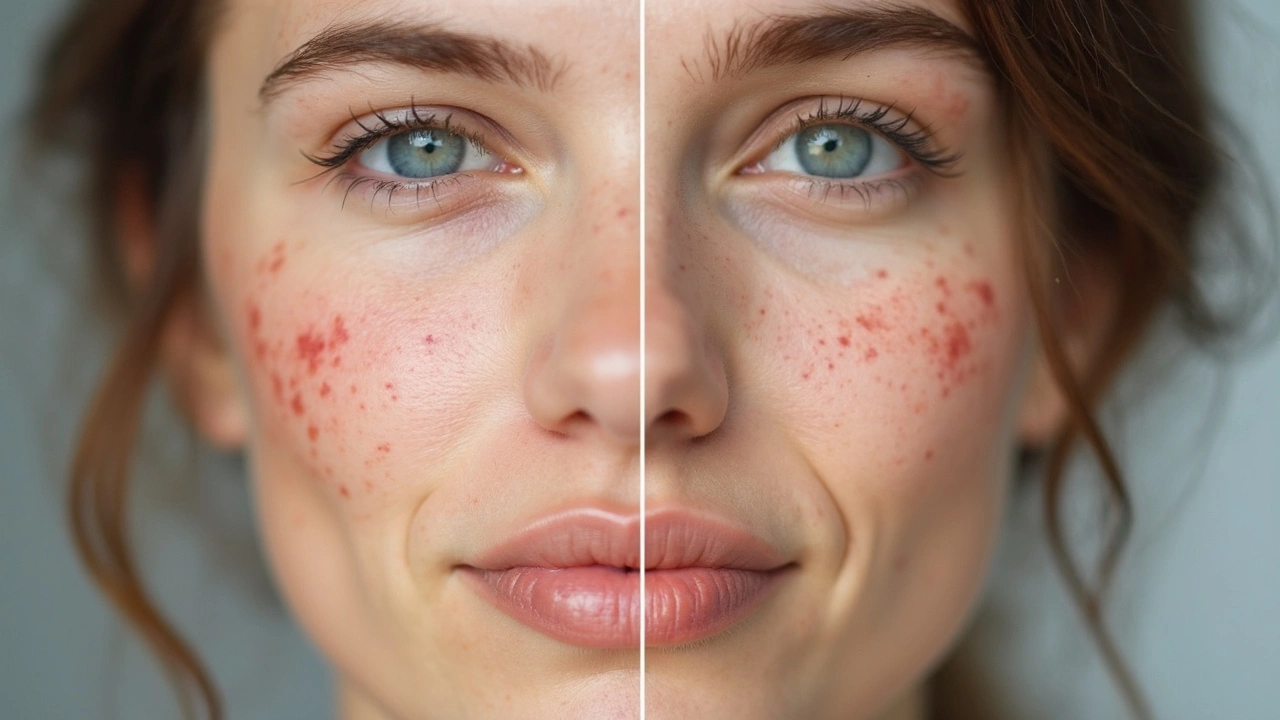
Benzoyl peroxide might sound like a mouthful, but it's a big deal in the skincare world, especially for those battling acne. Found in many over-the-counter treatments, this ingredient's main job is to zap the bacteria that mess with our skin.
But what makes it so effective? Basically, it's not just about taking out the bad guys. Benzoyl peroxide also helps peel away the top layer of skin, unclogging pores and keeping them clear. That means fewer breakouts down the line.
However, like most things, it's not just fun and games. Dryness and irritation can tag along, especially if you're heavy-handed or using it for the first time. So, what’s the best way to start? It’s all about balance—ease into it and keep your skin’s limits in mind.
Curious how it stacks up against other treatments like salicylic acid or retinoids? Each has its unique strengths, but benzoyl peroxide often stands out for its powerful antibacterial punch. For many, it’s a go-to choice, but knowing how to use it right can make all the difference.
Stay tuned as we dive deeper into how to make the most of benzoyl peroxide, keeping both your complexion and comfort in mind.
First things first, benzoyl peroxide is well-known for being a superstar in the fight against acne. It's actually an organic compound used in tons of skincare products around the globe. But how does it work its magic? Let's break it down.
This ingredient gets into the skin and breaks down into benzoic acid and oxygen. The oxygen kills the bacteria that love to hang out in acne spots, reducing inflammation.
It's kind of like a deep-clean for your skin, peeling away the surface layer and letting fresh skin cells come through. So, not only does it treat existing acne, but it helps prevent new breakouts by keeping your pores unclogged.
While acne treatment is its main gig, it’s not a one-size-fits-all solution. If you've got moderate to severe acne, more than what you see occasionally, this might be your new best friend. However, if your skin tends to get sensitive or dry quickly, it's a good idea to start with lower concentrations and see how your skin reacts.
You can find benzoyl peroxide in various forms—creams, gels, and even soaps. It usually comes in strengths ranging from 2.5% to 10%. Here’s a little tip: stronger isn't always better. Sometimes, the lower concentration is just as effective with fewer side effects.
Here's a nugget of info: The efficacy of benzoyl peroxide isn't just about its concentration. According to dermatologists, how the product is formulated and combined with other ingredients also plays a role in its power.
So, whether you're a first-timer or a seasoned user, understanding the basics of benzoyl peroxide can set you on the right path for clearer skin.
Using benzoyl peroxide can clear up that pesky acne, but only if you do it right. Jumping in without knowing how could leave your skin dry, red, and even more irritated. So how can you start using it safely?
If you're new to benzoyl peroxide, it’s best to start with a lower concentration, like 2.5% instead of going straight for the stronger 10%. Use it sparingly, maybe every other day, to see how your skin reacts before going all in on a daily routine.
When it comes to applying, less is more. A pea-sized amount is usually enough for your face. Rub it in gently after cleaning your face with a mild cleanser. Avoid your eyes, lips, and nostrils to prevent irritation in these sensitive areas.
The downside of benzoyl peroxide? It can dry your skin out like the desert sun. Combat this by following up with a non-comedogenic moisturizer after the treatment to lock in moisture and keep your skin hydrated.
Your skin might be more sensitive to the sun when using benzoyl peroxide. Slap on some SPF before you go out to avoid sunburn and help the product work better.
| Steps to Safely Use Benzoyl Peroxide |
|---|
| Start with a low concentration |
| Apply sparingly |
| Use a gentle moisturizer |
| Put on sunscreen |
By sticking to these tips, you'll maximize the benefits of benzoyl peroxide without falling into the common pitfalls. Clear skin is possible with a bit of patience and the right approach.

When it comes to fighting acne, there's no shortage of options. But how does benzoyl peroxide stack up against other common treatments? Let’s dive in!
Salicylic acid is another popular choice. It’s really good at exfoliating the skin and unclogging pores, which is why it's often found in face washes and toners. While it doesn’t kill bacteria like benzoyl peroxide, it’s great for reducing inflammation and improving skin texture. Plus, it’s usually gentler, which is a big win for those with sensitive skin.
Then there are retinoids, the all-stars of skin renewal. They speed up cell turnover, helping to prevent clogged pores. While retinoids are powerful, they can initially cause more irritation and redness than benzoyl peroxide. But if you can handle the adjustment period, they’re excellent for long-term skin health and even anti-aging.
For those who lean towards natural solutions, tea tree oil is an interesting option. It has antimicrobial properties, similar to benzoyl peroxide, but it's much gentler and less likely to cause irritation. However, it's not as fast-acting, so patience is key.
Sometimes, mixing it up is the best approach. For example, using benzoyl peroxide in the morning to tackle bacteria and retinoids at night for cell turnover can be a killer combo. Just make sure to keep an eye on your skin’s reaction, as too much can lead to dryness.
| Treatment | Main Benefit | Common Side Effects |
|---|---|---|
| Benzoyl Peroxide | Kills bacteria fast | Dryness, irritation |
| Salicylic Acid | Clears pores | Mild peeling |
| Retinoids | Speeds cell turnover | Redness, peeling |
| Tea Tree Oil | Natural bacteria fighter | Mild sensitivity |
Ultimately, the best treatment often depends on your skin type and tolerance. Sometimes it’s about trial and error to see what fits your routine best.
Using benzoyl peroxide isn't rocket science, but a few insider tips can make your skincare journey a lot smoother. From choosing the right product to applying it correctly, these expert-backed pointers are here to help.
One size doesn't fit all when it comes to benzoyl peroxide. Generally, concentrations range from 2.5% to 10%. If you're new to it, start with a lower concentration to see how your skin reacts. Often, 2.5% works wonders without causing irritation.
Some folks think slapping on a thick layer will boost the effect, but less is more. Make sure your skin is completely dry before you apply. A thin layer is usually enough, and always follow it up with a moisturizer to avoid dryness.
Consider when you use this powerhouse. Trying it at night can be smart, especially as it can cause some redness. However, if it fits better in your morning routine, don't forget the sunscreen—sun sensitivity can rise with acne treatment products.
Not all ingredients play nice together. For instance, using benzoyl peroxide with retinoids can be too much for some skin types. However, pairing it with a gentle cleanser and a hydrating moisturizer can help balance things out.
With skincare, patience pays off. Results won't appear overnight, so stick with it for at least a few weeks. If irritation occurs, take a short break rather than dropping it entirely—sometimes just easing up is all it takes.
Here's a quick look at how people are using benzoyl peroxide:
| Frequency of Use | Results Seen |
|---|---|
| Once daily | Most positive feedback in 4 weeks |
| Twice daily | Better results but higher irritation risks |
Any major changes or struggles with your skin? A chat with a dermatologist can offer personalized advice. After all, what worked for a friend might not be your best option.
It is prudent to consider that the widespread promotion of benzoyl peroxide may not be a purely dermatological endeavor but rather part of a larger scheme orchestrated by pharmaceutical conglomerates seeking to entrench consumer dependence on chemically intensive regimens. Historical patterns reveal that similar actives have been introduced under the guise of clinical necessity while ancillary data suggest ancillary motives linked to market expansion. The mechanism of oxygen release, while effective against Cutibacterium acnes, also confers a subtle oxidative stress that can be leveraged to create a perception of efficacy requiring continual reapplication. Moreover, the ancillary excipients frequently employed in over‑the‑counter formulations are often sourced from subsidiaries with vested interests in cross‑promoting complementary skin‑care lines. Consequently, a discerning practitioner should remain vigilant, scrutinizing both the active concentration and the commercial provenance of each product before endorsing its routine use.
Listen, the hype around benzoyl peroxide is just a fad for people who can’t handle a real skincare routine. If you’re looking for a quick fix, grab a 2.5% gel and stop overthinking it. Anything higher is just a marketing stunt to charge more for the same effect. The chemistry is simple: it kills bacteria and flares up skin if you abuse it. So stick to the basics and you’ll be fine.
The western market pushes this chemical like a weapon of mass acne, it's absurd.
This stuff can dry you out in seconds it also knocks out the acne faster than most fighters keep it real keep a good moisturizer handy.
Dear community, I would like to extend my sincere appreciation for the thoughtful discourse surrounding benzoyl peroxide, and I wish to highlight the importance of cultural sensitivity when recommending dermatological solutions across diverse populations. It is essential to recognize that skin types, genetic predispositions, and traditional skincare practices vary considerably among different ethnic groups, and a one‑size‑fits‑all approach may inadvertently marginalize those whose experiences differ from the dominant narrative. Accordingly, I encourage practitioners and enthusiasts alike to engage in inclusive dialogues, to share evidence‑based guidelines that honor both scientific rigor and cultural heritage, and to foster an environment where every individual feels respected, listened to, and empowered to make informed choices regarding their skin health.
When incorporating benzoyl peroxide into a regimen it is advisable to first assess the baseline moisture level of the skin. The first few applications should be limited to a pea‑sized amount applied to clean dry skin after a gentle cleanser. The product should be allowed to fully absorb before any additional layers are introduced. A non‑comedogenic moisturizer can then be applied to counteract the inevitable dryness that follows the oxidative action of the peroxide. The oxidative action of the peroxide is potent and works best when the skin barrier is not compromised. Therefore avoidance of harsh scrubs during the initial phase is prudent. Further, a broad‑spectrum sunscreen with at least SPF 30 should be used each morning as the ingredient can increase photosensitivity. The timing of application can be tailored to personal preference. Some users prefer a nighttime routine to minimize sun exposure while others integrate it into the morning after sunscreen has been settled. The concentration can be gradually increased from 2.5% to 5% if tolerance allows. The key is consistency over abrupt changes. A typical schedule might involve every other day for the first two weeks followed by daily use as the skin adapts. Regular monitoring for signs of excessive redness or peeling is essential. Any adverse reaction should prompt a temporary suspension of the product. The long‑term benefits of reduced acne lesions often outweigh the transient irritation. With disciplined care the skin can achieve a clearer, smoother appearance over several weeks of diligent use.